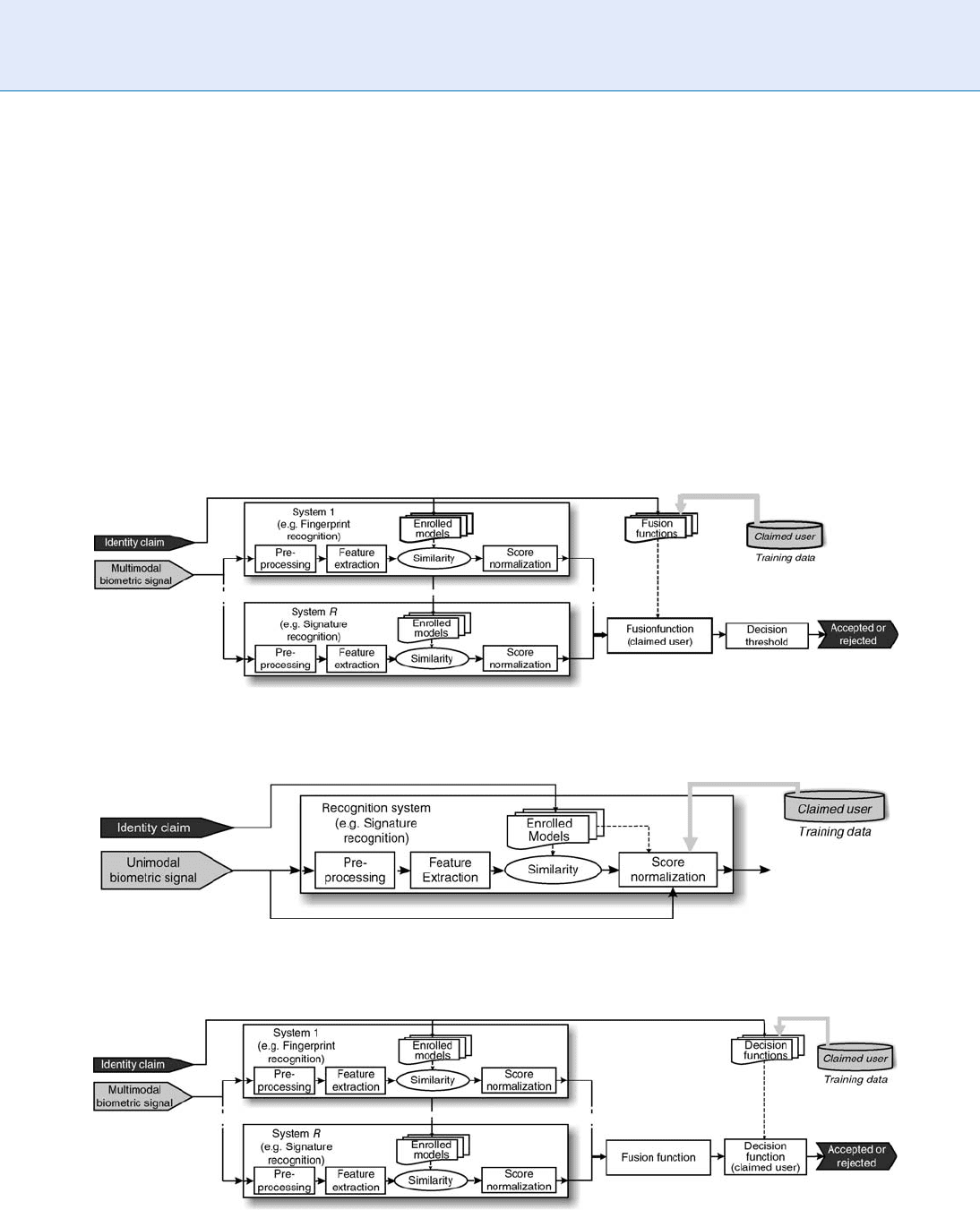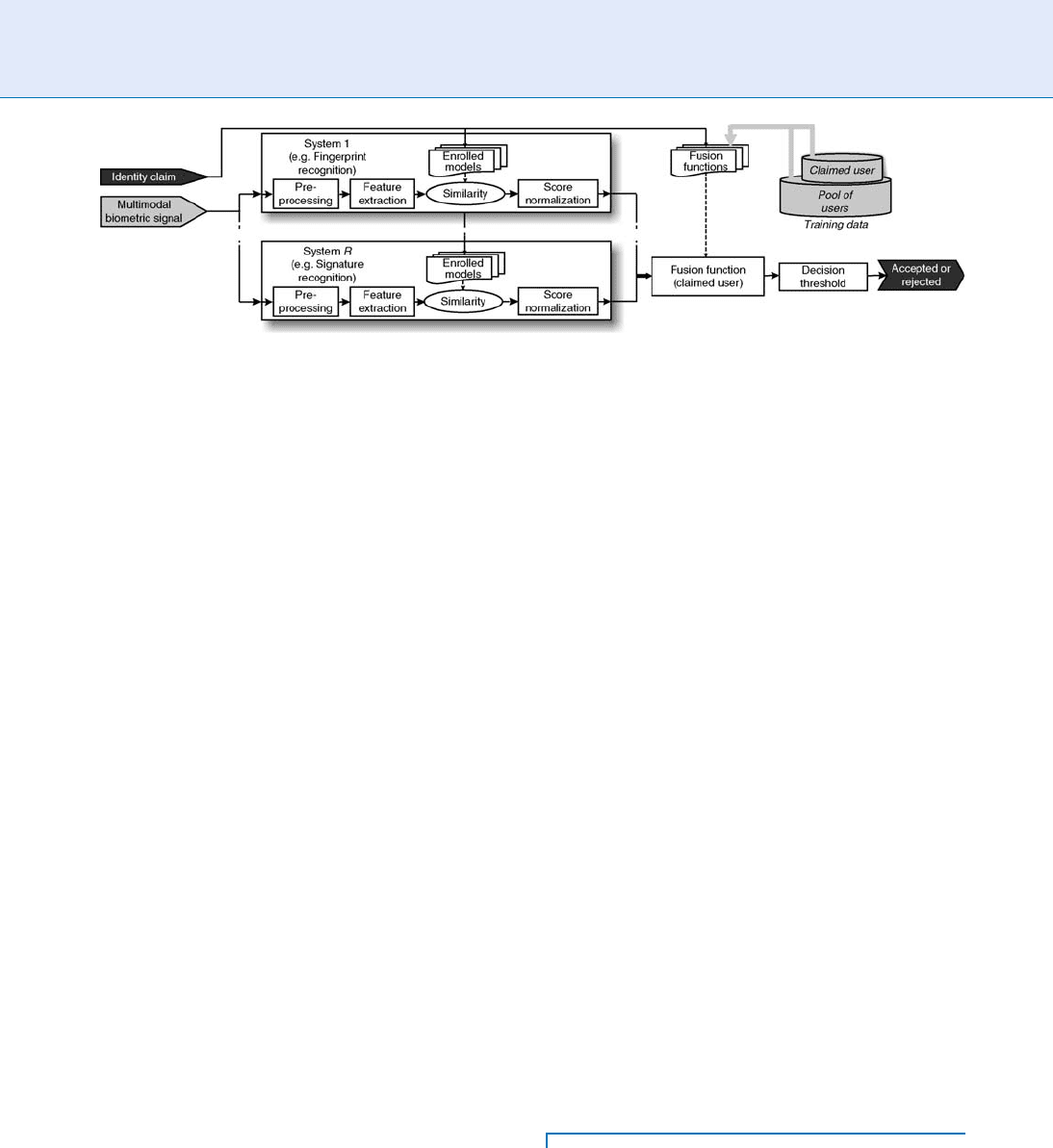Li S.Z., Jain A.K. (eds.) Encyclopedia of Biometrics
Подождите немного. Документ загружается.


Jing et al. [13] propose a sensor level fusion algo-
rithm that generates a composite image from face and
palmprint biometrics. Circular Gabor filters are first
applied on face and palm print images to generate 32
filtered responses of each biometric data. These filtered
responses are concatenated to generate a fused image.
A pixel normalization scheme is then used to minimize
variations due to imaging conditions. Finally, kernel
discriminative common vectors are extracted from the
fused image and radial basis function based neural net-
work is used for classification. The fusion algorithm
improves the recognition performance and is an effective
solution for the small sample size recognition problem.
Noore et al. [14] proposed discrete wavelet transforma-
tion based image fusion algorithm that generates
a composite image by combining multim odal bio-
metric images. The algorithm starts with transforming
biometric images into wavelet domain and genera-
ting composite image by amalgamating the wavelet
coefficients. The composite image is then scrambled
using a secret encoding key generated with Fibonacci
transforms. The algorithm not only improves the
recognition performance but also reduces the memory
requirements and provides resilience to common
image processing attacks such as smoothing, cropping,
JPEG 2000 compression, and filtering.
Future Research Directions
As discussed in previous sections, sensor level fusion
has several advantages. However, compared to other
levels of fusion, this level of fusion is less explored and
requires fur ther research to address the limitations of
current research. First and foremost is to further im-
prove the recognition accuracy. Researchers have
shown that for certain applications, sensor level fusion
algorithms do not provide better results compared to
match score level fusion algorithms [5, 11]. This is
mainly because existing algorithms do not effectively
reconcile the information that is useful for recognition.
We believe that existing sensor level fusion algorithms
fail in some cases because during information fusion
it is possible that redundant and less discriminatory
features become predominant. Furthermore, there is
a lack of generalized sensor level fusion algorithms
that can be used for different biometric scenarios or
applications. For instance, genetic algorithm based
multi-spectral image fusion algorithm can not be
directly used for multimodal image fusion. Additional
research is required to design an effective and generalized
sensor level fusion algorithm which can be applied to
different biometric modalities. Every sensor level fusion
algorithm requires specific feature extraction algorithm
that can effectively extract discriminatory biometric in-
formation from the composite image or data. This
requirement is not mandatory with a generalized sen-
sor level fusion algorithm. Therefore, a generalized al-
gorithm can be easily incorporated in commercial
systems and can conform to data fusion standards.
Another important research issue is to unify the
sensor level fusion in a
▶ unification framework that
reconciles multiple fusion algorithms. Originally pro-
posed by Vatsa et al. [15], a biometric unification
framework combines multiple fusion algorithms by
dynamically selecting the most appropriate fusion algo-
rithm depending on the input evidences such as quality
and other priors. Currently, the unification framework
includes only the match score fusion algorithms. How-
ever, with proper modifications, the unification frame-
work can be expanded to include multi-level fusion
algorithms that can address the operational needs
of biometric systems and provide better recognition
performance.
Related Entries
▶ Data Fusion
▶ Face Recognition
Fusion, Sensor-Level. Figure 4 Multimodal image fusion. (a) Image pertaining to different biometric modalities and
(b) Fused and scrambled image.
620
F
Fusion, Sensor-Level

▶ Identification
▶ Verification
References
1. Ross, A., Nandakumar, K., Jain, A.K.: Handbook of Multibio-
metrics. 1st edn. Springer, New York (2006)
2. Singh, R., Vatsa, M., Ross, A., Noore, A.: A mosaicing scheme for
pose-invariant face recognition. IEEE Trans. Syst. Man Cybern.
Part B 37(5), 1212–1225 (2007)
3. Ratha, N.K., Connell, J.H., Bolle, R.M.: Image mosaicing for
rolled fingerprint construction. In: Proceedings of International
Conference on Pattern Recognition, pp. 1651–1653 (1998)
4. Jain, A., Ross, A.: Fingerprint mosaicking. In: Proceedings of
International Conference on Acoustics, Speech, and Signal Pro-
cessing, pp. 4064–4067 (2002)
5. Ross, A., Shah, S., Shah, J.: Image versus feature mosaicing: a
case study in fingerprints. In: Proceedings of SPIE Conference
on Biometric Technology for Human Identification III, pp.
620,208-1–620,208-12 (2006)
6. Yang, F., Paindavoine, M., Abdi, H., Monopoly, A.: Development
of a fast panoramic face mosaicing and recognition system. Opt.
Eng. 44(8), 087 005/1–087 005/10 (2005)
7. Lu, X., Jain, A.K.: Pose-robust face recognition using geometry
assisted probabilistic modeling. In: Proceedings of International
Conference on Computer Vision and Pattern Recognition, pp.
502–509 (2005)
8. Kong, S., Heo, J., Abidi, B., Paik, J., M., A.: Recent advances in
visual and infrared face recognition - a review. Comput. Vision
Image Understand. 97(1), 103–135 (2005)
9. Bebis, G., Gyaourova, A., Singh, S., Pavlidis, I.: Face recognition
by fusing thermal infrared and visible imagery. Image Vision
Comput. 24(7), 727–742 (2006)
10. Kong, S., Heo, J., Boug horbel, F., Zheng, Y., Abidi, B.,
Koschan, A., Yi, M., M., A.: Multiscale fusion of visible and
thermal IR images for illumination-invariant face recognition.
Int. J. Comput. Vision 71(2), 215–233 (2007)
11. Singh, R., Vatsa, M., Noore, A.: Integrated multilevel image
fusion and match score fusion of visible and infrared face images
for robust face recognition. Pattern Recognit. 41(3), 880–893
(2008)
12. Lu, X., Jain, A.K.: Integrating range and texture information for
3D face recognition. In: Proceedings of Workshop on Applica-
tions of Computer Vision, pp. 156–163 (2005)
13. Jing, X.Y., Yao, Y.F., Zhang, D., Yang, J.Y., Li, M.: Face and
palmprint pixel level fusion and Kernel DCV-RBF classifier for
small sample biometric recognition. Pattern Recognit. 40(11),
3209–3224 (2007)
14. Noore, A., Singh, R., Vatsa, M.: Robust memor y efficient data
level information fusion of multi-modal biometric images. Inf.
Fusion 8(4), 337–346 (2007)
15. Vatsa, M., Singh, R., Noore, A.: Unification of evidence theoretic
fusion algorithms: A case study in level-2 and level-3 fingerprint
features. In: Proceedings of IEEE International Conference on
Biometrics: Theory, Applications, and Systems, pp. 1–6 (2007)
Fusion, User-Specific
JULIAN FIERREZ,JAV IE R ORT EG A-GARCIA
Biometric Recognition Group – ATVS, Escuela
Politecnica Superior, Universidad Autonoma de
Madrid, Campus de Cantoblanco, Madrid, Spain
Synonyms
Adapted fusion; Local fusion; Target-dependent
fusion; User-dependent fusion
Definition
User-specific fusion in the framework of biometrics,
initially devised for score fusion in the verification
mode, refers to techniques used for information fusion
in which there is a specific fusion function for each
user enrolled in the system. These fusion functions are
retrieved and used fo r information integration in the
same way the enrolled templates corresponding to the
claimed identities are retrieved and used for matching.
User-specific fusion techniques find application in
several biometric fusion scenarios, e.g., multi-modal
fusion, where some subjects may be not adequate for
recognition based on specific modalities (these evi-
dences can be ignored or given less importance in the
information fusion step), or multi-algorithm fusion,
where some subjects may be better recognized based on
particular algorithms (their fusion functions can be
adapted to give more importance to those algorithms).
The biggest challenge for effective user-specific
fusion is the need for user-specific training data,
which is usually very scarce. Recent user-specific fusion
techniques exploit the usually scarce training data by
considering also for training the information provided
by background users. These new techniques are known
as adapted user-specific fusion.
System Model
The following nomenclature is used throughout the
essay. Given a multi-biometric verification system con-
sisting of a number of uni-modal systems, each one
computes a similarity score between an input bio met-
ric pattern and the enrolled pattern or model of the
Fusion, User-Specific
F
621
F

given claimant. The similarity scores are then normal-
ized to a given score range. Let the normalized similar-
ity scores provided by the different uni-modal systems
be combined into a multi-modal score. The design of a
fusion scheme consists in the definition of a function
which maps a multi-modal score to a fused real value,
so as to maximize the separability of client and impos-
tor fused score distributions. This function may be
fixed or trained (see the entry in this encyclopedia on
Multi-biometrics) by using a set of training scores
(scores known to be genuine or impostor).
The aim in user-specific fusion is to obtain the best
score fusion function for a particular user, resulting in
the system model shown in Fig. 1.
User-Specific Multi-Biometrics
User-specific multi-biometric verification can be
achieved not only by making the fusion functions
user-specific as shown in Fig. 1, but also other proces-
sing modules, such as the score normalization and the
decision processing blocks. In the first case, each indi-
vidual system will be used as indicated in Fig. 2, in the
latter case the overall system diagram will be as indi-
cated in Fig. 3.
On one hand, user-specific score normalization has
been traditionally studied for individual behavioral bio-
metric modalities in which there are large variations
between users (such as speech [1] or signature [2]),
Fusion, User-Specific. Figure 1 System model of multi-biometric verification with user-specific score fusion.
Fusion, User-Specific. Figure 2 System model of biometric verification with user-specific score normalization.
Fusion, User-Specific. Figure 3 System model of multi-biometric verification with user-specific decision functions.
622
F
Fusion, User-Specific

where their application is very effective to compensate
the problems related to the heterogeneity between
users. When user-specific score normalization is
used in one of the systems being combined in a
multi-biometric setup, the resulting approach can be
seen as integrati ng the multi-biometric data in a user-
specific way [3]. Despite the success of user-specific
score normalization in individual modalities, and the
success of fusion techniques, few efforts have been
reported in the literature studying the combined use
of both techniques to make the most out of the usually
scarce user-specific training data.
On the other hand, the use of user-specific decisions
in multi-biometrics has been typically studied in
combination with user-specific score fusion. In this
case, it has been demonstrated that it is better to use
the available training data for computing user-specific
fusion functions instead of user-specific decision
schemes [4].
User-Specific Fusion
The idea of exploiting user-specific parameters at the
score level in multi-modal biometrics was introduced,
to the best of our knowledge, by [5]. In that work, user-
independent weighted linear combination of similarity
scores was demonstrated to be improved by using
either user-specific weights or user-specific decision
thresholds, both computed by exhaustive search on
the testing data. The idea of user-specific fusion para-
meters was also explored by [6]. Other attempts to
personalize multi-modal biometrics include the use
of the claimed identity index as a feature for a global
trained fusion scheme based on neural networks [7],
computing user-specific weights using lambness
metrics [8], and using personalized Fisher ratios [9].
The existing score fusion approaches can be classi-
fied as global or local depending first on the fusion
function (i.e., user-independent or user-specific fusion
strategies) and secondly on the decision making process
(i.e., user-independent or user-specific decision thresh-
olds), resulting in [10]: global-learning-global-decision
(GG), local-learning-global-decision (LG), and simi-
larly GL and LL. Some example works on user-specific
multi-biometrics using this classification are: LG [4 , 5,
6, 7, 8, 10, 11], GL [4, 5, 10], and LL [4, 10].
User-specific score fusion is confronted with a great
challenge: the scarcity of user-specific training scores.
For overcoming this challenge, the simultaneous use of
user-specific and background information has been
proposed for training the user-specific fusion func-
tions, in what has been called adapted user-specific
fusion. This approach can be seen as a particular case
of a more general type of approaches, referred to as
▶ adapted fusion [11]. In these approaches, a baseline
fusion function is first constructed based on some
general knowledge of the problem at hand, and then
adjusted during the operation of the system . The ad-
aptation can be based on ancillary information such as:
the user being claimed (adapted user-specific fusion),
quality measures of the input biometrics (quality-
based fusion [12], see related entry in this encyclope-
dia), or other kind of environmental information af-
fecting the variou s information channels being fus ed.
Adapted User-Specific Fusion
Adapted methods in the context of user-specific fusion
refer to the use of both global and local information for
learning the fusion func tions.
The idea of adapted learning is based on the fact
that the amount of available training data in localized
learning is usually not sufficient and representative
enough to guarantee good parameter estimation and
generalization capabilities. To cope with this lack of
robustness derived from partial knowledge of the
problem, one can exploit the information provided
by background global data. In general, the relative
balance between the background information (pool
of users) and the local data (specific user) is performed
as a tradeoff between both kinds of information.
The system model of adapted user-specific score
fusion is shown in Fig. 4, where we can see that the
fusion function of a given user is trained with two sets
of training data, both including both genuine and
impostor matc hing scores. The first training set con-
sists of scores corresponding to the user being claimed.
The second set consists of scores corresponding to a
pool of background users different to the user being
claimed. By considering these two sets simultane ously,
the resulting adapted user-specific fusion schemes out-
perform the traditional user-independent fusion (also
known as
▶ global fusion, in which only the pool
of users is used for training), and the traditiona l
user-specific fusion depicted in Fig. 1 (also known as
▶ local fusion, in which only data from the claimed
Fusion, User-Specific
F
623
F

user is used for training). This affirmation has been
demonstrated experimentally in various scenarios,
such as multi-algorithm speaker verification [3, 13],
and multi-modal verification combining on-line sig-
nature and fingerprint traits [4, 11].
Related Entries
▶ Fusion, Qualit y-Based
▶ Multi-Algorithm Systems
▶ MultiBiometrics
▶ Multi-Modal Systems
References
1. Doddington, G., Liggett, W., Martin, A., Przybocki, M., Reynolds,
D.: Sheeps, goats, lambs and wolves: a statistical analysis of speaker
performance in the NIST 1998 speaker recognition evaluation. In:
Proceedings of International Conference on Speech and Language
Processing, ICSLP (1998)
2. Fierrez-Aguilar, J., Ortega-Garcia, J., Gonzalez-Rodriguez, J.:
Target dependent score normalization techniques and their
application to signature verification. IEEE Trans. Syst. Man
Cybernet., Part C 35 , 418–425 (2005)
3. Poh, N., Kittler, J.: Incorporating model-specific score distribu-
tion in speaker verification systems. IEEE Trans. Audio Speech
Lang. Process. 16, 594–606 (2008)
4. Fierrez-Aguilar, J., Garcia-Romero, D., Ortega-Garcia, J., Gonzalez-
Rodriguez, J.: Adapted user-dependent multimodal biometric
authentication exploiting general information. Pattern Recognit.
Lett. 26, 2628–2639 (2005)
5. Jain, A.K., Ross, A.: Learning user-specific parameters in a multi-
biometric system. In: Proceedings of IEEE International Confer-
ence on Image Processing, ICIP, vol. 1, pp. 57–60 (2002)
6. Wang, Y., Wang, Y., Tan, T.: Combining fingerprint and voice
biometrics for identity verification: An experimental comparison.
In: Zhang, D., Jain, A.K. (eds.) Proceedings of International
Conference on Biometric Authentication, ICBA, Springer LNCS-
3072, pp. 663–670 (2004)
7. Kumar, A., Zhang, D.: Integrating palmprint with face for user
authentication. In: Proceedings of Workshop on Multimodal
User Authentication, MMUA, pp. 107–112 (2003)
8. Snelick, R., Uludag, U., Mink, A., Indovina, M., Jain, A.K.: Large
scale evaluation of multimodal biometric authentication using
state-of-the-art systems. IEEE Trans. Pattern Anal. Mach. Intell.
27, 450–455 (2005)
9. Poh, N., Bengio, S.: An investigation of f-ratio client-dependent
normalisation on biometric authentication tasks. In: Proceed-
ings of the IEEE International Conference on Acoustics, Speech
and Signal Processing, ICASSP, vol. 1, pp. 721–724 (2005)
10. Toh, K.A., Jiang, X., Yau, W.Y.: Exploiting local and global
decisions for multimodal biometrics verification. IEEE Trans.
Signal Process. 52, 3059–3072 (2004)
11. Fierrez-Aguilar, J., Garcia-Romero, D., Ortega-Garcia, J., Gon-
zalez-Rodriguez, J.: Bayesian adaptation for user-dependent
multimodal biometric authentication. Pattern Recognit. 38,
1317–1319 (2005)
12. Fierrez-Aguilar, J., Ortega-Garcia, J., Gonzalez-Rodriguez, J.,
Bigun, J.: Discriminative multimodal biometric authentication
based on quality measures. Pattern Recognit. 38, 777–779 (2005)
13. Fierrez-Aguilar, J., Garcia-Romero, D ., Ortega-Garcia, J., Gonzalez-
Rodrigez, J.: Speaker verification using adapted user-dependent
multilevelfusion.In:Oza,N.C.,Polikar,R.,Kittler,J.,Roli,F.
(eds.) Proceedings of International Workshop on Multiple
Classifier Systems, MCS, Springer LNCS-3541, pp. 356–365 (2005)
Fusion, Wavelet-Based
Wavelet-based fusio n has been widely used in litera-
ture. The wavelet transform is a data analysis tool that
provides a multi-resolution decomposition of an
image. Wavelet-based pixel-level data fusion is used
on two or more sets of probe images. Given two
Fusion, User-pecific. Figure 4 System model of multi-modal biometric authentication with adapted user-specific
score fusion.
624
F
Fusion, Wavelet-Based

registered images I
1
and I
2
of the same object from two
sets of probe images (two different spectral bands in
this case), a two-dimensional discrete wavelet decom-
position is performed on I
1
and I
2
to obtain the wavelet
approximation coefficients (a
1
, a
2
) and detail coeffi-
cients (d
1
, d
2
). The wavelet approximation and detail
coefficients of the fused image, a
f
and d
f
, are then
calculated as follows:
a
f
¼W
a
1
a
1
þ W
a
2
a
2
and
d
f
¼W
d
1
d
1
þ W
d
2
d
2
;
where W
a
1
; W
a
2
; W
d
1
, and W
d
2
are weights deter-
mined either empirically or according to some selected
rule. The two-dimensional discrete wavelet inverse
transform is then performed to obtain the fused image.
▶ Multispectral and Hyperspectral Biometrics
Fuzzy Extractor
▶ Encryption, Biometric
▶ Fingerprints Hashing
Fuzzy Vault
Fuzzy vault is where a secret key is hidden behind some
biometric data which are fuzzy and noisy by nature.
▶ Fingerprints Hashing
Fuzzy Vault
F
625
F


G
Gabor Jets
Gabor jets are a set of filters that are used to extract the
local frequency information from the face images.
These filters are generally linear filter with impulse
responses defined by a harmonic function and a
Gaussian function. The Fourier transform of a Gabor
filter’s impulse response is the convolution of the
Fourier transform of the harmonic function and
the Fourier transform of the Gaussian function.
▶ Face Recognition, Component-Based
Gabor Transform
A complete representation of a signal or image in terms
of coefficients on Gabor wavelets, such that the original
data can be reconstructed exactly by combining togeth-
er those wavelets using their computed coefficients. A
complication is that the necessary coefficients cannot
be obtained simply by operations of filtering or by the
inner product projections of the data with the wavelets,
since they do not constitute an or thogonal basis. More
complex methods are required (biorthogonal bases;
relaxation networks) to obtain the needed expansion
coefficients from projection coefficients. Once
obtained, a Gabor Transform is a powerful tool for
signal or image encoding, analysis, and compression.
▶ Iris Encoding and Recognition using Gabor
Wavelets
Gabor Wavelets
Complex exponentials (Fourier components) multi-
plied by Gaussian envelopes. Although they fail to
satisfy some parts of the stricter mathematical defini-
tions of wavelets, such as orthogonality and compact
support, these elementary functions can constitute a
powerful basis for signal or image encoding, represen-
tation, compression, and analysis. They are increas-
ingly used today in computer vision and in pattern
recognition, particularly in biometrics, where they
are the basis of iris recognition and have also been
used for several other biometric modalities. Among
their advantages (besides forming a complete basis
for signal or image encoding) are; their optimality
under the Heisenberg Uncertainty Principle for simul-
taneous resolution in time/space and in frequency;
their closed analytical form; their self-Fourier property
and closure under convolution and multiplication;
and their neurobiological basis in the receptive field
profiles of neurons in the mammalian visual cortex.
Their chief disadvantage is that they are not mutually
orthogonal, and so the projection coefficients obtained
by computing their inner product with an image are
not the same as the expansion coefficients that would
be needed to reconstruct the same image exactly
from them.
▶ Face Recognition, Component Based
▶ Iris Encoding and Recognition using Gabo r
Wavelets
▶ Local Image Features
▶ Local Image Filters
#
2009 Springer Science+Business Media, LLC

Gait
The manner of a person’s movement, specifically dur-
ing walking is called gait. The human gait cycle consists
of two main phases: during stance phase, the foot is on
the ground, and during the swing phase, the leg is
swinging forward in preparation for the next ground
contact.
▶ Gait, Forensic Evidence of
Gait Analysis
▶ Gait, Forensic Evidence of
Gait Biometrics, Overview
RAMA CHELLAPPA,ASHOK VEERARAGHAVAN
NARAYANAN RAMANATHAN
University of Maryland, College Park, MD, USA
Synonym
Gait recognition
Definition
Gait is defined as the style or manner of walking. Studies
in physchophysics suggest that people can identify famil-
iar individuals using just their gait. This has led to a
number of automated vision based algorithms that use
gait as a biometric. Such a system usually consists of a
video camera capturing images of a person walking with-
in its field of view. Appropriate features such as joint
angles or silhouettes are extracted from this video and are
then used to compare with the stored gait signatures of
known individuals. As with any other biometric system,
the system can operate in both the identification and
the verification mode. Gait as a biometric has several
advantages compared to traditional biometrics such as
fingerprint in that gait is non-intrusive, does not require
cooperation from the individual, and can function at
moderate distances from the subject.
Introduction
The study of human gait has gathered pace in recent
years driven primarily by its potential as a biometric.
Gait-based person authentication has several signifi-
cant advantages compared to traditional biometrics
such as fingerprint or iris. Firstly, gait based biometric
systems do not require the individuals to be cooperative
since the input of these systems is the video feed cap-
tured by passive cameras. Secondly, gait is a non-intru-
sive biometric – it does not require the individuals to
wear any special equipment in order to be recognized.
Thirdly, gait based biometric systems have an extended
range compared to traditional biometrics – they can
operate reliably even when the subjects are tens of
meters away from the camera. Finally, such a system
harnesses the potential of thousands of surveillance
video cameras installed in public locations into a bio-
metric authentication system.
Operation of a Gait Based Biometric
System
The sensor for a gait-based biometric system is a video
camera capturing videos of human subjects walking
within its field-of view. The raw sensor video is then
processed to extract relevant features which can then be
used for recognition. If the acquisition conditions are
expected to be controlled and favorable, then the quality
of the video will enable the extraction of features such as
joint angles from the individual video frames. In more
typical uncontrolled settings, the features extracted could
either be background subtracted binary images, silhou-
ettes, shapes or width vectors – all examples of features
capturing the extent of the human body to differing
amounts of detail. During the training phase, several
such sequences of each individual in the gallery ar e col-
lected and the appropriate features are then stored in the
database. During the test phase, each test sequence is
compared with the training sequences available in the
database and the similarity is used to perform person
authentication.
628
G
Gait

Challenges for Gait Based Biometrics
Systems
The discriminative information in gait is present in
both the shape of the individual and also in the manner
of his/her gait. This means that gait based biometric
systems must be able to model gait as a time series of
features or as a dynamical model in order to perform
accurate recognition. Static template based methods
which have been used for most other biometric systems
need to be adapted to a temporal sequence in order to
achieve robust performance. In this regard, another
challenge is time alignment of two sequences so that
critical events during gait like ‘‘mid-stance’’, ‘‘toe-off ’’
etc. are time aligned accurately so that recognition per-
formance is not affected by inaccurate time alignment
between postures that occur during gait. Since, gait
based person identification often occurs without any
particular viewpoint, view-invariance of the feature
extracted from the video is another important challenge.
This will ensure that recognition performance is robust
to changes in the viewpoint of the camera. In scenarios
with moderate amounts of acquisition control, one can
set up multiple video cameras so as to ensure that the
best possible viewpoint which happens to be the fronto-
parallel gait is captured on atleast one of the cameras.
Another challenge for automated gait-based biometrics
is that of changing illumination conditions in the scene.
In order to be robust to changing illumination condi-
tions, background subtraction is typically performed on
the raw videos before the video data is used in a recogni-
tion algorithm. Finally, another important challenge is
the variability in the clothing, shoe type and the surface
on which the individuals walk. Obviously, the clothing of
the subject especially their type of footwear has signifi-
cant impact on the gait features observed and it is im-
portant to bear this in mind while developing gait-based
biometric systems.
Features for Gait Based Biometrics
Silhouette: In most gait-based biometric systems the
cameras can be assumed to be static during the short
duration of time that they capture the gait of a single
individual for verification. This allows simple back-
ground models to be built for each of these cameras.
Background subtra ction then identifies the set of
all pi xels in the image that belong to the moving
individual. Figure 1 shows a sequence of color images
captured by a video camera as a person walks through
its field of view. Shown below are the binary back-
ground subtracted images in which all pixels belonging
to the individual are white, while the background is
black. This binary image is then scaled to a uniform
size so that the feature extracted is independent of the
distance of the camera from the subject. Several algo-
rithms for gait based person identification use this
binary silhouette as a feature [1–5].
Shape: ‘‘Shape is all the geometric information
that remains when location, scale, and rotational
effects are filtered out from the object’’[6]. Kendall’s
statistical shap e is a sparse descriptor of the shape that
describes the shape configuration of k landmark points
in an m-dimensional space as a km matrix contain-
ing the coordinates of the landmarks. Image space is
2-dimensional and therefore it is convenient to de-
scribe the shape vector as a k dimensional complex
vector. First, a binarized silhouette denoting the extent
of the object in an image is obtained. A shape feature
is then extracted from this binarized silhouette. This
feature vector must be invariant to translation and
scaling since the object’s identity should not depend
on the distance of the object from the camera. So any
feature vector that we obtain must be invariant to
translation and scale. This yields the pre-shape of the
object in each frame. Pre-shape is the geometric infor-
mation that remains when location and scale effects are
filtered out. Let the configuration of a set of k landmark
points be given by a k-dimensional complex vector
containing the positions of landmarks. Let us denote
this configuration as X. Centered pre-shape is obtained
by subtracting the mean from the configuration and
then scaling to norm one. The centered pre-shape is
given by
Z
c
¼
CX
k CX k
; where C ¼ I
k
1
k
1
k
1
T
k
; ð1Þ
where I
k
is a k k identity matrix and 1
k
is a
k dimensional vector of ones.
The advantage of using shape feature is that the
differential geometric properties of the spherical man-
ifold in which the shapes lie are very well understood
and therefore, appropriate distance measures that can
account for translational, rotational and scale invar-
iances are well defined. For example, consider two
complex configurations X and Y with corresponding
preshapes a and b. The full Procrustes distance
Gait Biometrics, Overview
G
629
G
